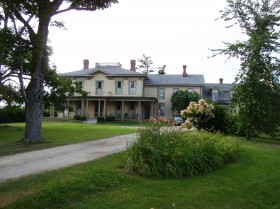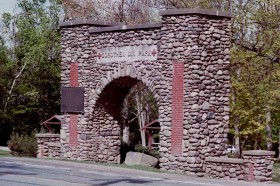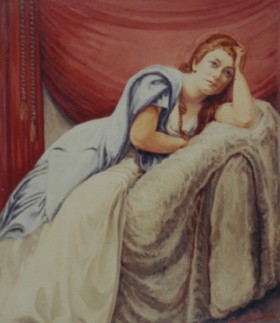Assertive and Independent: Maine Women in the World
by Polly Welts Kaufman
From a presentation at the June 6, 2008 Norlands Conference.
Maine women in every imaginable field have left the state taking their independent spirits, imagination, talents, and education to make their marks on the world. Others remained, breaking new ground in many areas.
Ante bellum* pioneer teachers Mary Adams from Bangor, Flora Davis Winslow and Elizabeth Lincoln from Portland, and Sarah Parker from Foxcroft brought their teaching experiences in Maine schools to found schools in Missouri, Indiana, Oregon, and Port Royal, South Carolina, respectively. Hampden’s Dorothea Dix became superintendent of nurses in the Civil War. With Gorham and Portland in her background, Ellen Gould Harmon White co-founded the Seventh Day Adventist Church. Although Joanna Colcord was born on shipboard in the South Seas, it was on a Searsport bark. She later expressed her independence with a long career in social work in New York City. From the turn of the 20th century operatic divas admired both in the United States and abroad, Lillian Nordica, born in Farmington, and Emma Eames, of Bath, to the Rockland schooled avant-garde sculptor Louise Nevelson and Camden born Edna St. Vincent Millay, Maine women influenced the arts.
We can only look briefly here at the lives of these amazing women but first we do need ask a few questions. Why did they leave Maine? Did their earlier experiences in the state help them develop the confidence and spirit of self-sufficiency they needed in order to compete in the wider world? Were their reasons for leaving and the areas in which they achieved success comparable to the experiences of men who left Maine to achieve success outside the state?
Let’s start with the ante bellum pioneer teachers. The westward movement was in full swing, but the picture that is usually presented is of single men searching for gold or families in covered wagons crossing the prairies. But single women were also caught up by the same spirit of adventure combined with a goal of “doing good.” In the 1840s and early 1850s, sixteen Maine women were sent by the National Board of Popular Education, after six weeks training in Hartford, Connecticut, to start schools in the West. The requirements were that they were experienced teachers and they had to be unmarried.
Their most common reason, as expressed by Flora Davis Winslow of Portland, as she left to open a school in Michigan, was, “I felt there was a wider sphere of influence there than here.” On her way to Missouri, Mary Adams from Bangor, a recent graduate of Mount Holyoke Seminary, said that she had “a desire to see something of the world we live in.” Both became Western settlers.
Elizabeth Lincoln of Portland was one of five women sent by the Board to the Oregon frontier. They traveled by ship in 1851 except when they crossed the Isthmus of Panama by mule. The Oregonians, including the families and single men, were waiting for them with open arms. Elizabeth married a justice of the Oregon Supreme Court and together they started one of the first schools in Astoria. After teaching in Indiana, Sarah Parker became a teacher in one of the first freedmen’s schools established in Port Royal, South Carolina, early in the Civil War.1
Dorothea Dix’s childhood in Hampden on the frontier of Maine – then Massachusetts – was a rugged one and in 1819 while in her early teens she left for Boston to care for her grandmother. After teaching and starting a school, she was caught up in the ante bellum reform movement. Her turning point came when she observed the conditions of the women in an East Cambridge jail where she had agreed to teach a Sunday School class. Her horror at the conditions there and the realization that many of the inmates were mentally ill led her to present a famous memorial to the Massachusetts state legislature demanding action to improve the plight of mentally ill people. She not only surveyed conditions by personal visits throughout Massachusetts but in many other states, demanding reform. Her work was encouraged by many male reformers but it was she who was in charge of her projects. When she became superintendent of Union army nurses in the Civil War, Dorothea not only required the nurses to be single but also to be “plain looking women” over thirty.2
Another Maine born 19th century woman reformer achieved national fame as co-founder of the Seventh-Day Adventist church. Born in Gorham, Ellen Gould Harmon attended the Brackett Street School in Portland’s West End where she was struck on the head by a brick (The building still stands and has a grocery store downstairs and a community center upstairs). The incident changed her life and although always frail, from then on she had occasional visions which she revealed to eager listeners. A group ready to listen were Millerites who had recently become disenchanted by the failure of the apocalyptic predictions of the sect. She married James Springer White, a young Adventist preacher. Together they spread the word and in 1863 formally organized the church in Battle Creek, Michigan, based on Ellen’s interpretation of the Bible. She added general instructions about health, education, and temperance to what became a nine-volume publication. After the death of her husband in 1881, she took an even stronger leadership role for the Seventh-Day Adventists whose churches had spread across the country. She continued her influence for 35 more years until her death at her home in California.3
Maine’s seafaring tradition put families on the move and expanded women’s roles. In a study of maritime families from Searsport in the 1880 census, John Battick found 89 married shipmasters. Of those, 40 percent (or 36) of their wives were listed as being at sea. The wives who remained at home had to transact business, settle accounts, rule and provide for their families. The wives on board learned navigation, sometimes softened harsh discipline, taught (and bore) children, tended chickens and in a few cases assumed command in an emergency. What effect did life at sea have on the daughters? A good example is Joanna Colcord, who was born in the South Seas on the bark Charlotte A. Littlefield out of Searsport, spent her girlhood at sea until the age of eighteen. She later wrote that seafaring children knew the “bright face of danger” and “early learned to face realities, and our lives were not sheltered as are those of shore children.” Although she is best known for publishing two collections of sea shanties, Joanna had a long career in New York City working for philanthropic organizations. She married for the first time at 68, living ten more years.4
Perhaps it was Maine’s seafaring tradition that led two of Maine’s successful operatic divas to not only venture abroad for their operatic training but to debut in European opera houses. Nordica was born Lillian Norton on her family’s struggling farm in Farmington, and Emma Eames, who although she was born in Shanghai where her father worked as a lawyer, was brought up by her grandparents who lived in Bath. The performance of music in Maine in the late 19th and early 20th centuries was a valued community activity taking place both in churches and in musical societies. When a “voice” was discovered, usually belonging to a soloist in a church choir, it was not unusual for the singer to be encouraged to pursue formal voice training, but to take the step for operatic training in Europe, took confidence and funds.
Both of these divas found a way to study and perform in Europe. On borrowed money backed by community pride, Eames traveled with her mother to Europe to train with Mathilde Marchesi. The Bath newspapers followed their activities and said that Eames was “one of the most fascinating women that Maine ever sent out to the world.” Her operatic debut was in Paris singing the role of Juliette in Gounod’s Romeo and Juliette. Eames returned to New York where she continued at the Metropolitan Opera for eighteen years.
Lillian Norton had an even more dramatic career as a diva. In order to get musical training at the New England Conservatory, her family moved to Boston where her mother worked at Jordan Marsh. Lillian joined Gilmore’s Brass Band in Boston but when she joined the band on a European tour in 1878 (with her mother as a chaperone), she found her chance. They left the band in France. Lillian studied with an Italian voice teacher and supported her mother and herself by giving music lessons. Her debut was in Milan in the role of Elvira in Mozart’s Don Giovanni. Her Italian voice teacher named her Nordica (she was also called the “Lily of the North”). She sang in Russia, Italy, and France and was the first American singer to perform Wagner at Bayreuth – Elsa in Lohengrin. When she was in the United States, Nordica used her talents to support woman suffrage, once posing as Columbia on the steps of the U.S. Capitol in a Washington, D.C. suffrage pageant. Nordica’s death harked back to Maine’s seafaring tradition. On a tour around the world, her ship was wrecked off the coast of Java; she died in a hospital on the island of Batavia. Nordica was cremated in London and her estranged husband carried her ashes to an unknown place in America. Eames, on the other hand, is buried under an elaborate self-designed monument in a Bath cemetery.5
Before asking our questions – Why did these remarkable women leave Maine? How did living in Maine prepare them for their careers? Were their experiences comparable to those of men of their generation? Let’s jump to the early and mid 20th century for the stories of two Maine women originals who were caught up in the Bohemian life in New York City: artist Louise Nevelson and poet Edna St. Vincent Millay. They were both born in the last decade of the 19th century, but Nevelson lived into her late 80’s and Millay only into her fifties.
One of Maine’s most fascinating exports was Louise Nevelson who first immigrated to Rockland with her family when she was five from Kiev in Ukraine. Her father parlayed his role as a junk dealer into being a real estate developer. Although Louise was encouraged by her art teachers in Rockland, where she graduated from high school, she was always conscious of her Eastern European roots and felt like an outsider. She used an early marriage as her ticket to New York. After trying different kinds of artistic expression, Nevelson eventually became famous for her wooden sculptures often made out of found materials, painted black like Rockland’s tar-blackened piers and referencing her father’s early work as a junk dealer. Although she lived a classic Bohemian existence, she came to the realization that her feelings of being a foreigner in Rockland served as a source of inspiration. Before her death in 1988, she exhibited and donated 56 of her own works to the Farnsworth Art Museum in Rockland. She was somewhat hesitant about how she and her sculptures would be received. Marius Peladeau, then the museum director, remembered her visit. “I think she was afraid of coming back, but when she did, decades later, she was overwhelmed at the reception. Rockland had changed and everybody came to the museum. Rockland realized she was a doyenne of American Art.”6
Edna St. Vincent Millay was brought up in Camden by an impoverished divorced mother who worked as a nurse but encouraged artistic expression in her three daughters. Edna’s poem, Renascence, describing the depth of her feelings as she sat one morning on the top of Mt. Battie in the Camden Hills, was so well received that a summer visitor sponsored her education at Vassar College. She was a wildly popular poet in the 1920s and received a Pulitizer prize for her poetry collection, Ballad of the Harp Weaver, in 1923. Everyone, it seems, could quote her description of how she lived her life:
My candle burns at both ends.
It will not last the night;
But ah, my foes, and oh, my friends
It gives a lovely light.
In 1923, at the peak of her popularity, she married a native of Holland, Eugen Jan Boissevain, who gave her a great deal of support throughout her illnesses. They first lived in Greenwich Village but soon made their home on a farmstead in Steepletop, in Austerlitz, N.Y., now a museum devoted to Millay. She remained close to her family, mostly through correspondence, and she and her husband built a summer home on Ragged Island in Casco Bay. In the late 1920s she threw her energy and support toward social causes including the effort to save Sacco and Vanzetti from execution. Both her poems and her life reflect her love of nature, her free spirit, and her sense of justice.7
Interestingly enough, the Maine women who we think of as being especially significant today were Mainers to begin with or even come to Maine as adults to do their work. Margaret Chase Smith, a native of the state, was the first woman to be elected in her own right to the U.S. Senate. Joan Benoit Samuelson whose winning Olympic gold medal marathon run of 2:24.52 in 1984 was not passed until 2003, is also a native. Other women found inspiration in Maine by coming as adults: photographer Berenice Abbott, scientist Rachel Carson, environmentalist Helen Nearing, and even politician Libby Mitchell.
Maybe Maine has always been a two-way street for women but no matter whether they were coming or going, many of them can be characterized as having an independent spirit.
*Before the Civil War
1Polly Welts Kaufman, Women Teachers on the Frontier. New Haven: Yale University Press, 1984.
2Helen E. Marshall, “Dorothea Lynde Dix” in Edward T. James and Janet Wilson James, eds., Notable American Women: A Biographical Dictionary, Cambridge, MA: Harvard University Press, 1971, pp. 486-489.
3C.C. Goen, “Ellen Gould Harmon White,” in Notable American Women, 1971, pp. 585-588.
4John F. Battick, “The Searsport ‘Thirty-six’: Seafaring Wives of a Maine Community in 1880,“ American Neptune, 44/3 (Summer 1984): 149-154; Joanna Colcord” in Maine Folklife Center, University of Maine; Parker Bishop Albee, Letters from Sea, 1882-1901: Joanna and Lincoln Colcord’s Seafaring Childhood. Gardiner, ME.: Tilbury House Press, 1999.
5Norma Johnsen and Allison L. Hepler, “Downeast Divas” in Marli F. Weiner, Of Place and Gender: Women in Maine History. Orono: University of Maine Press, 2005, pp. 287-315.
6Sarah Cummng Cecil, “Thoroughly Novel Nevelson,” Portland Magazine, April, 2008, pp. 59-61; Laurie Lisle, “Louise Nevelson” in Susan Ware, ed., Notable American Women, Cambridge, MA: Harvard University Press, 2004, pp. 467-468.
7 John Malcolm Brinnin, “Edna St. Vincent Millay” in Notable American Women, 1971, pp. 536-538.




